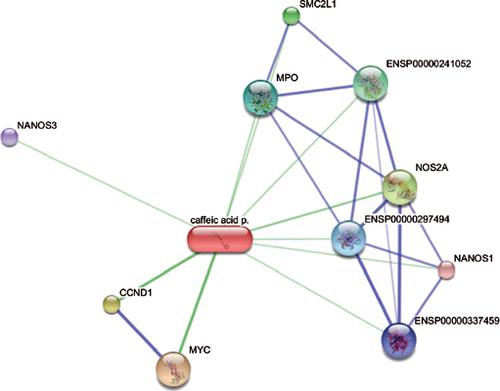Letters in Drug Design & Discovery ( IF 1.2 ) Pub Date : 2020-05-01 , DOI: 10.2174/1570180815666180803111902 Yuhao Zhao 1 , Xiaokun Pang 1 , Akriti Nepal 2 , Xincan Jiang 1 , Xiaoxin Xu 3 , Dongbin Zhao 4 , Ghulam Murtaza 4 , Yanxu Ma 5

|
Background: Biological system complexity impedes the drug target identification by biological experiments. Thus drugs, rather than acting on target site only, can interact with the entire biological system. Study of this phenomenon, known as network pharmacology, provides grounds for biological target identification of new drugs or acts as a foundation for the discovery of new targets of present drugs. No publication is available on the interaction network of CAPE.
Aim: This study was aimed at the investigation of the candidate targets and possible interactions of caffeic acid phenethyl ester (CAPE) involved in its osteoimmunological effects.
Methods: This study encompasses the investigation of candidate targets and possible interactions of CAPE by analyzing through PASS Prediction and constructing a biological network of CAPE.
Results: In response to input (CAPE), PASS Prediction generated a network of 1723 targets. While selecting the probability to be active (Pa) value greater than 0.7 brought forth only 27 targets for CAPE. Most of these targets predicted the therapeutic role of CAPE as an osteoimmunological agent. Apart from this, this network pharmacology also identified 10 potential anti-cancer targets for CAPE, out of which 7 targets have been used efficiently in developing potent osteoimmunological drugs.
Conclusion: This study provides scientific prediction of the mechanisms involved in osteoimmunological effects of CAPE, presenting its promising use in the development of a natural therapeutic agent for the pharmaceutical industry. CAPE targets identified by web-based online databases and network pharmacology need additional in silico assessment such as docking and MD simulation studies and experimental verification to authenticate these results.
中文翻译:

咖啡酸苯乙基酯的作用:计算机模拟其骨免疫机制
背景:生物系统的复杂性阻碍了通过生物实验识别药物靶标。因此,药物不仅可以在目标部位起作用,还可以与整个生物系统相互作用。对这种现象的研究(称为网络药理学)为新药的生物学靶标鉴定提供了依据,或为发现现有药物的新靶标奠定了基础。CAPE的交互网络上没有可用的出版物。
目的:本研究旨在调查咖啡酸苯乙酯(CAPE)的候选靶标及其可能的相互作用,从而参与其骨免疫学作用。
方法:本研究包括通过PASS预测分析和构建CAPE的生物学网络,对CAPE的候选目标和可能的相互作用进行调查。
结果:响应输入(CAPE),PASS Prediction生成了1723个目标的网络。选择大于0.7的活动概率(Pa)时,仅提出了27个CAPE目标。这些靶中的大多数预测了CAPE作为骨免疫药的治疗作用。除此之外,该网络药理学还确定了10种针对CAPE的潜在抗癌靶标,其中7种靶标已被有效地用于开发有效的骨免疫药物。
结论:这项研究为CAPE的骨免疫作用机制提供了科学的预测,表明了CAPE在制药业天然治疗剂开发中的应用前景。基于Web的在线数据库和网络药理学确定的CAPE目标需要进行其他计算机评估,例如对接和MD仿真研究以及实验验证,以验证这些结果。











































 京公网安备 11010802027423号
京公网安备 11010802027423号